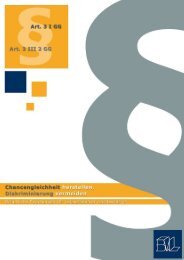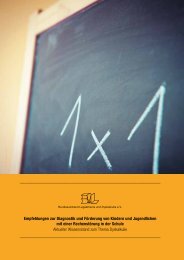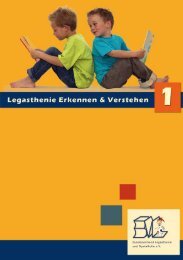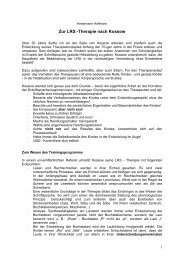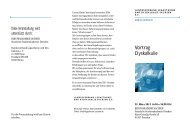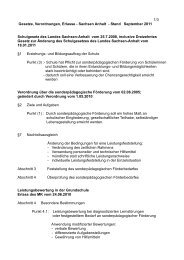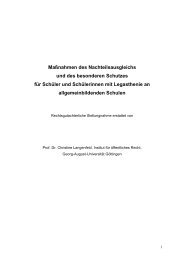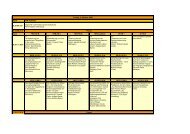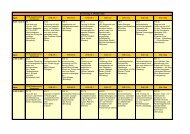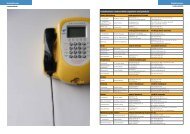Abstractband zum 16. Kongress des Bundesverbandes Legasthenie
Abstractband zum 16. Kongress des Bundesverbandes Legasthenie
Abstractband zum 16. Kongress des Bundesverbandes Legasthenie
Sie wollen auch ein ePaper? Erhöhen Sie die Reichweite Ihrer Titel.
YUMPU macht aus Druck-PDFs automatisch weboptimierte ePaper, die Google liebt.
<strong>16.</strong> <strong>Kongress</strong> <strong>des</strong> Bun<strong>des</strong>verban<strong>des</strong> <strong>Legasthenie</strong> <strong>Abstractband</strong><br />
Neural correlates of number processing of simple arithmetic in children<br />
with and without dyscalculia<br />
Liane Kaufmann<br />
Medical University, Department of Pediatrics IV, Section Neuropediatrics, Innsbruck, Austria<br />
Good calculation skills are important in modern society. Individuals with significant<br />
calculation difficulties (i.e., developmental dyscalculia) have a considerable disadvantage<br />
in both academic and occupational activities. Prevalence rates of developmental<br />
dyscalculia equal those of developmental dyslexia and have been estimated at about 5 to<br />
7% of the elementary school population. Most major theories about numerical cognition<br />
are derived from adult studies and consequently, many developmental studies are based<br />
upon adult calculation models which may not be fully applicable to developing brain and/<br />
or cognitive systems.<br />
Recently there have been important advances, characterizing crucial differences between<br />
developmental and mature neurocognitive systems supporting number processing<br />
and calculation (as well as their interplay with non-numerical cognitive domains). There<br />
is converging evidence from both human and non-human primate studies that parietal regions<br />
play a key role in number magnitude processing. Functional imaging studies have<br />
shown that independent of age, average calculators recruit parietal brain regions when<br />
asked to solve numerical and arithmetical tasks. However, parietal activations are less<br />
robust in children and moreover, children seem to have a stronger need to recruit frontal<br />
brain regions upon performing numerical tasks (most possibly reflecting compensatory<br />
efforts). Imaging studies assessing children with dyscalculia are scarce and results thus<br />
far are rather heterogeneous. Our most recent findings are suggestive of (a) a correlation<br />
between parietal activation extents and arithmetic competence level; and (b) a large<br />
interindividual variability both with respect to imaging and behavioral data. Results will be<br />
discussed with respect to current conceptualizations of developmental dyscalculia.<br />
Korrespondenzautor:<br />
Liane Kaufmann<br />
liane.kaufmann@i-med.ac.at<br />
++43 512 23600<br />
++43 512 50423247<br />
Über Sinn und Unsinn der numerischen Frühförderung<br />
Liane Kaufmann (1), Pia Handl (2)<br />
(1) Medizinische Universität Innsbruck, Pädiatrie IV, Innsbruck, Österreich<br />
(2) Schulpsychologie Innsbruck Land Ost, Innsbruck, Österreich<br />
Gewöhnlich beherrschen Kinder bereits vor Schuleintritt das Zählen bis 10 oder sogar<br />
20, können einfache Additionen und Subtraktionen ausführen und verstehen sogar<br />
schon, dass sich Mengen aus Teilmengen zusammensetzen. Jene Kinder, die Schwierigkeiten<br />
beim Rechnen lernen haben, zeigen häufig auch im Kindergartenalter kein Inte-<br />
65



